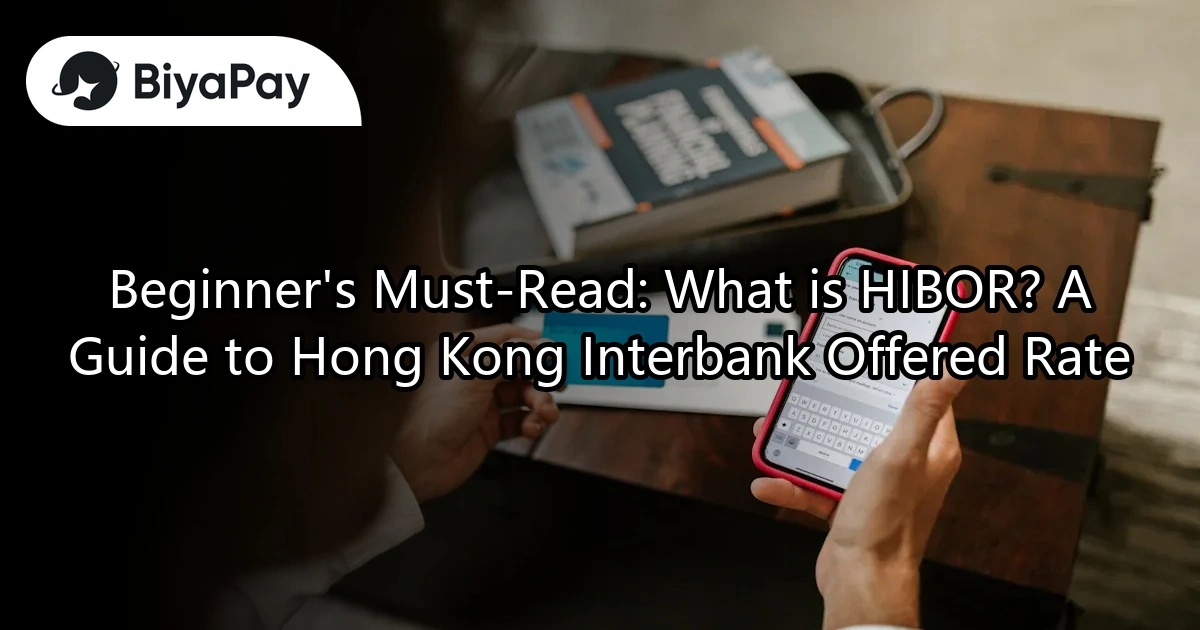- EasyCard
- Trade
- Help
- Announcement
- Academy
- SWIFT Code
- Iban Number
- Referral
- Customer Service
- Blog
- Creator
Beginner's Must-Read: What is HIBOR? A Guide to Hong Kong Interbank Offered Rate

Image Source: pexels
If you are considering buying a property or managing finances, you must pay attention to the interbank offered rate. Recently, according to HKMA statistics, the proportion of H-mortgage usage has risen to 91.8%, reflecting a preference for mortgage products linked to HIBOR. When HIBOR falls, mortgage rates decrease immediately, easing housing payment pressures. HIBOR fluctuations also affect short-term deposit rates and investment directions, with many investors turning to high-yield stocks or ETFs due to low interest rates. Whether you choose an H-mortgage or a P-mortgage, your decision will be influenced by interbank offered rate fluctuations.
Key Points
- HIBOR is the interest rate for short-term lending between Hong Kong banks, varying daily based on market supply and demand for funds.
- HIBOR directly affects mortgage rates and monthly payments; rising rates increase housing payment pressures, while falling rates ease the burden.
- Banks set a cap rate for HIBOR mortgages, ensuring payments do not exceed a maximum limit, reducing risk.
- When choosing a mortgage, H-mortgage rates fluctuate with the market, while P-mortgage rates are more stable; decisions should be based on personal financial conditions.
- Closely monitoring HIBOR changes and bank cap rates, along with consulting professional advice, helps make informed financial and mortgage decisions.
What is the Interbank Offered Rate

Image Source: unsplash
HIBOR Definition
When managing finances or buying a property in Hong Kong, you often hear the term “interbank offered rate.” In fact, the interbank offered rate (HIBOR, full name Hong Kong Interbank Offered Rate) refers to the interest rate used when Hong Kong banks lend funds to each other. You can think of it as a reference price for banks’ “short-term borrowing.” Every morning, the Hong Kong Association of Banks calculates HIBOR for different tenors based on quotes from major banks. These rates fluctuate with market supply and demand for funds.
Tip: If you choose an H-mortgage (i.e., a mortgage linked to HIBOR), your housing interest rate will adjust based on HIBOR’s daily changes.
You can refer to the following specific cases to understand the fluctuations of the interbank offered rate in the Hong Kong market:
- On March 17, 2015, the overnight RMB interbank lending rate in Hong Kong reached 4.98%, higher than China’s Shanghai Interbank Offered Rate (Shibor) overnight rate of 3.43%, showing an interest rate inversion.
- After the Spring Festival, Hong Kong’s RMB interbank overnight lending rate once surged to 8%, indicating significant volatility in the interbank rate.
- Several Hong Kong banks (e.g., Nanyang Commercial Bank, Wing Lung Bank, Hang Seng Bank) offered one-year RMB deposit rates exceeding 4%, significantly higher than China’s maximum rate of 3.25%, reflecting a supply-demand imbalance in Hong Kong’s RMB funds, pushing up the interbank offered rate.
- According to HKMA data, as of January 2015, Hong Kong’s RMB stock was approximately USD 981.4 billion, with about USD 9.9 billion in net cross-border capital flowing into China via the Shanghai-Hong Kong Stock Connect, primarily “northbound,” affecting Hong Kong’s RMB fund supply-demand and interbank offered rate fluctuations.
Role in Financial Markets
You need to understand that the interbank offered rate is not just a lending rate between banks; it is also an important liquidity indicator in financial markets. When HIBOR rises, it indicates tight market liquidity, increasing banks’ borrowing costs. When HIBOR falls, it suggests abundant market liquidity, making it easier for banks to borrow.
- HIBOR reflects offshore RMB liquidity, with rate changes directly showing market liquidity conditions and RMB exchange rate pressures.
- Judy Wang, Head of Greater China FX and Rates Strategy at BNP Paribas, noted that a decline in HIBOR indicates loose offshore RMB liquidity, helping China maintain a weaker RMB to hedge against tariff risks.
- Ken Cheung, Chief Asian FX Strategist at Mizuho Bank, stated that capital inflows into Hong Kong’s stock market replenish offshore RMB liquidity, suppressing interbank rates, with lower short-term RMB appreciation pressure when market sentiment is stable.
- Market reports emphasize that global capital flows, US dollar index changes, and funds flowing into Hong Kong’s stock market are reflected through HIBOR, highlighting the interbank offered rate’s role as a key liquidity indicator in financial markets.
If you care about mortgage rates, deposit rates, or investment market trends, you must closely monitor changes in the interbank offered rate. This rate not only affects borrowing costs between banks but also impacts your daily financial management and housing expenses.
Interbank Offered Rate Calculation and Types
Calculation Method
You may wonder how Hong Kong banks calculate the interbank offered rate. In fact, the Hong Kong Association of Banks collects quotes from major Hong Kong banks around 11 a.m. daily and calculates the interbank offered rate for different tenors. These rates are expressed as annualized percentage rates, reflecting the actual cost of short-term fund lending between banks.
According to the calculation rules of the Hang Seng China Enterprises Short Index, this index directly uses the overnight interbank offered rate published by the Hong Kong Association of Banks as a calculation parameter. This practice shows that the interbank offered rate is not only a reference rate for banks but also affects the return calculations of financial products. For example, when the interbank offered rate rises, the index’s short strategy leverage and returns adjust accordingly. You can see that this rate has practical application value in financial markets.
Tip: You can check the latest daily interbank offered rate data on the Hong Kong Association of Banks’ website to understand market liquidity conditions.
Tenor Classifications
The interbank offered rate has different tenor classifications, allowing you to choose the appropriate reference rate based on your needs. Common classifications include:
- Overnight
- 1 Week
- 1 Month
- 3 Months
- 6 Months
- 12 Months
The table below briefly lists common tenors and their uses:
| Tenor | English Name | Common Uses |
|---|---|---|
| Overnight | Overnight | Short-term bank fund allocation |
| 1 Week | 1 Week | Short-term fund lending |
| 1 Month | 1 Month | Mortgage rates, short-term loans |
| 3 Months | 3 Months | Mortgage rates, corporate financing |
| 6 Months | 6 Months | Medium-term loans, fund management |
| 12 Months | 12 Months | Long-term loans, investment products |
When choosing a mortgage or financial product, banks price based on the interbank offered rate for different tenors. Generally, homebuyers most commonly use the one-month or three-month interbank offered rate as the mortgage rate benchmark. You should select the most suitable tenor based on your needs.
HIBOR and Mortgages

Image Source: unsplash
H-Mortgage Rates
When applying for a mortgage in Hong Kong, banks offer different mortgage rate plans. The H-mortgage (HIBOR mortgage) is one common option. H-mortgage rates are based on HIBOR, typically using the 1-month HIBOR plus a fixed spread. For example, HSBC’s H-mortgage calculation is “1-month HIBOR + 1.3%.” Assuming the 1-month HIBOR on March 22, 2023, was 3.37%, the H-mortgage rate would be 4.67%. If you choose an H-mortgage, the bank will automatically adjust your mortgage rate monthly based on the latest HIBOR data.
Tip: You can check daily HIBOR data on the Hong Kong Association of Banks’ website to see if your mortgage rate will change.
As a mortgage rate benchmark, HIBOR directly affects your housing costs. When market liquidity is tight and HIBOR rises, your H-mortgage rate will increase accordingly. Conversely, when market liquidity is ample and HIBOR falls, your housing rate will decrease. This mechanism allows you to reflect market rate changes instantly but also requires you to bear the risk of rate fluctuations.
Payment Impact
HIBOR fluctuations directly affect your monthly payments. When HIBOR rises, banks’ borrowing costs increase, raising your mortgage rate and monthly payment amount. According to market reports, HIBOR once hit a ten-year high in recent years, significantly increasing payment pressures for many homebuyers. If your original monthly payment was USD 2,000 (calculated at 1 USD = 7.8 HKD), a 1% rise in HIBOR could increase your payment to USD 2,150 or more.
You can refer to the following simple example to understand the impact of HIBOR fluctuations on payments:
| HIBOR Rate | H-Mortgage Rate (HIBOR+1.3%) | Monthly Payment (30-year term, USD 400,000 loan) |
|---|---|---|
| 2.00% | 3.30% | USD 1,750 |
| 3.37% | 4.67% | USD 2,000 |
| 5.00% | 6.30% | USD 2,350 |
You can see that for every 1% increase in HIBOR, monthly payments rise significantly. This volatility greatly affects your financial planning. If you choose an H-mortgage, you must reserve sufficient cash flow to handle rising rates.
Note: When HIBOR falls, your payments decrease, which is good news for borrowers. However, if HIBOR remains high for a long time, your payment pressure will continue to grow.
Cap Rate
To protect you from extremely high payment burdens due to sharp HIBOR increases, Hong Kong banks typically set a “cap rate” for H-mortgages. This cap rate is the maximum upper limit for your mortgage rate. Even if HIBOR rises further, your actual mortgage rate will not exceed this level.
According to market reports, when HIBOR remains elevated for a long time, banks may consider adjusting the cap rate upward to reflect funding costs and risk management needs. For example, in 2023, several banks raised H-mortgage cap rates due to sustained high HIBOR levels. This ensures banks have enough profit margin while giving you confidence in knowing the maximum payment level.
You can refer to the following list to understand the role of the cap rate:
- The cap rate protects you from unaffordable payments due to extreme market volatility.
- Banks adjust the cap rate based on market conditions, typically 1% to 2% higher than the current H-mortgage rate.
- When HIBOR is below the cap rate, your payments fluctuate with HIBOR; when HIBOR exceeds the cap rate, your payments are calculated at the cap rate.
Tip: You should pay special attention to the cap rate setting when choosing an H-mortgage and calculate whether you can afford the maximum payment amount.
H-Mortgage vs. P-Mortgage
Main Differences
When choosing a mortgage, you most common options are the H-mortgage (HIBOR mortgage) and the P-Mortgage (prime-rate mortgage). The key difference lies in the rate calculation basis:
- H-mortgages are based on the Hong Kong Interbank Offered Rate (HIBOR), with rates adjusting to market fund movements.
- P-mortgages are based on the bank’s prime rate (Prime Rate, P), which is more stable with less frequent adjustments.
You can refer to the following data to understand their actual performance:
- In September 2023, 1-month HIBOR rose to 2.29%, and H-mortgage rates reached their cap levels.
- During the same period, P-mortgage rates rose due to banks increasing the prime rate, with the MMI index rising from 1.58% to 2.28%.
- By December 2023, the proportion of H-mortgage usage fell to 67.5%, while P-mortgage usage rose to 26%.
- For a USD 641,667 loan (approx. 5 million HKD, at 1 USD = 7.8 HKD) over 30 years, monthly payments increased from USD 2,233 to USD 2,567, a rise of about 15%.
Pros and Cons
You can compare H-mortgages and P-mortgages from the following aspects when considering them:
| Plan | Pros | Cons |
|---|---|---|
| H-Mortgage | Rates track the market closely, with lower payment pressure when HIBOR is high. | Large rate fluctuations; payments surge when HIBOR is low. |
| Cap rates provide protection, capping maximum payments. | Cap rates may rise with market adjustments. | |
| P-Mortgage | Rates are stable with less frequent adjustments. | Rates rise when banks adjust the prime rate. |
| Suitable for those seeking stable cash flow. | Less attractive than H-mortgages when market rates are high. |
Tip: When HIBOR is low, some banks’ P-mortgage actual rates may be higher than H-mortgage cap rates, attracting more new mortgage clients to choose H-mortgages.
Selection Advice
When choosing a mortgage plan, you should make judgments based on your financial situation and risk tolerance. Multiple professional reports indicate that government and Hong Kong Mortgage Corporation’s promotion of reverse mortgage programs emphasize consumer protection and risk management, offering you important references. You can:
- Compare H-mortgage and P-mortgage rates, cap rates, and preferential terms across different banks.
- Assess your income stability and ability to tolerate rate fluctuations.
- Refer to official reports and market data to understand the latest mortgage trends.
- Consult professionals or use resources from the government and Hong Kong Mortgage Corporation if you have questions.
Note: Market rates change rapidly, so do thorough research before choosing to ensure you select the most suitable mortgage plan for yourself.
You must closely monitor changes in the interbank offered rate during financial management and homeownership. According to Hong Kong Financial Authority data, bank system balances once fell to negative USD 133.8 billion, with overnight HIBOR at around 2.1% and USD rates at about 4.8%. These data show that market liquidity and rate spreads directly affect HIBOR, which in turn impacts your mortgage rates and payment pressures. You should compare plans from different Hong Kong banks, paying attention to cap rates and rate fluctuations. If you have questions, it’s recommended to consult professionals to make the best choice for yourself.
FAQ
Does HIBOR change every day?
Yes, HIBOR changes daily based on the supply and demand for funds between Hong Kong banks. You can check the latest data on the Hong Kong Association of Banks’ website.
Tip: HIBOR is usually announced around 11 a.m.
Which is better for you, H-mortgage or P-mortgage?
If you want rates to track the market, choose an H-mortgage. If you seek stable cash flow, choose a P-mortgage. It’s suggested to compare rates and cap rates from different banks.
Will rising HIBOR significantly increase payment pressures?
Yes. As HIBOR rises, your H-mortgage rate will increase accordingly, raising monthly payments. You need to reserve enough cash flow to cover this.
What does cap rate mean?
The cap rate is the maximum interest rate ceiling set by banks for H-mortgages. Even if HIBOR rises further, your mortgage rate won’t exceed this level.
Can you switch between H-mortgage and P-mortgage anytime?
You can apply to switch through your bank, but there may be handling fees. You should review contract terms before deciding.
In 2025, HIBOR fluctuations raise H-press mortgage payments, while exchange risks and high remittance fees increase cross-market investment costs. BiyaPay empowers you in low-rate environments with a single account for US and Hong Kong stocks, eliminating multi-platform complexity. International transfers cost just 0.5%, with real-time market rate conversions to minimize losses. Online account opening takes minutes, avoiding high fees.
BiyaPay’s 5.48% annualized return product outperforms bank deposits, boosting idle funds. Compliant in New Zealand (FSP) and U.S. (MSB), supervised by regulators. Join BiyaPay now to optimize investing and financing! Sign up today to grow your wealth in 2025!
*This article is provided for general information purposes and does not constitute legal, tax or other professional advice from BiyaPay or its subsidiaries and its affiliates, and it is not intended as a substitute for obtaining advice from a financial advisor or any other professional.
We make no representations, warranties or warranties, express or implied, as to the accuracy, completeness or timeliness of the contents of this publication.




Contact Us
Company and Team
BiyaPay Products
Customer Services
is a broker-dealer registered with the U.S. Securities and Exchange Commission (SEC) (No.: 802-127417), member of the Financial Industry Regulatory Authority (FINRA) (CRD: 325027), member of the Securities Investor Protection Corporation (SIPC), and regulated by FINRA and SEC.
registered with the US Financial Crimes Enforcement Network (FinCEN), as a Money Services Business (MSB), registration number: 31000218637349, and regulated by FinCEN.
registered as Financial Service Provider (FSP number: FSP1007221) in New Zealand, and is a member of the Financial Dispute Resolution Scheme, a New Zealand independent dispute resolution service provider.


















